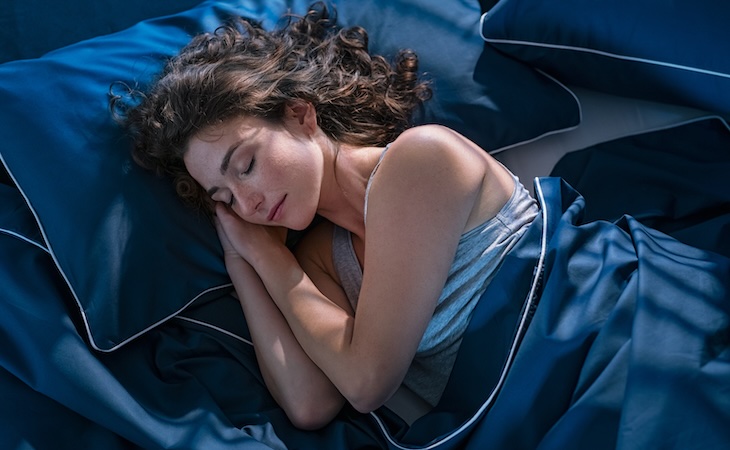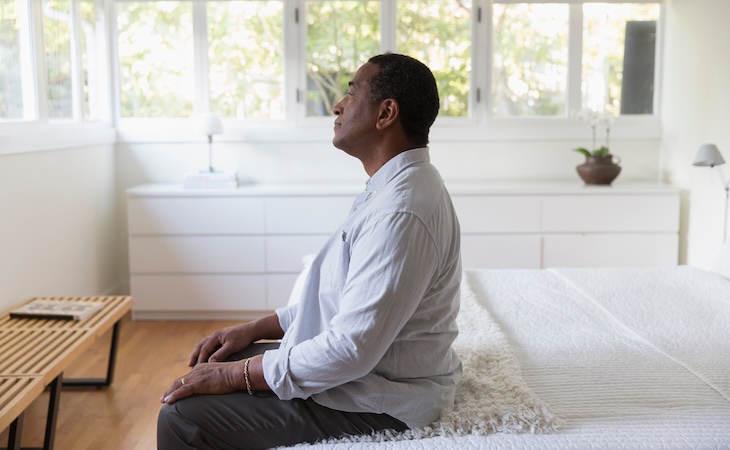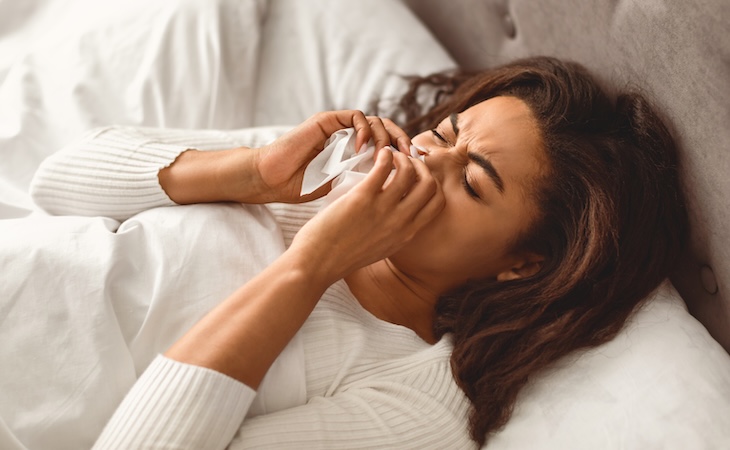Getting high-quality sleep can change your life for the better. But getting great rest can also be a challenge—and to overcome that challenge, you want to have as many get-better-sleep techniques in your arsenal as possible.
One of those techniques that’s having a serious moment? Sleep syncing. Let’s take a deep dive into sleep syncing: what it is, how it works, and how to use it to get better sleep.
What is sleep syncing?
The sleep syncing trend first started gaining traction on TikTok—but, as it turns out, it’s just a classic sleep technique packaged in a new way.
“Sleep syncing is a trendy term for aligning your sleep habits with your circadian rhythm,” says Shelby Harris, PsyD, director of sleep health at Sleepopolis. “But the concept isn’t new—it’s just basic sleep hygiene repackaged.”
Sleep syncing emphasizes learning your body’s natural circadian rhythm, building your sleep schedule around it, and then (and this is the important part!) sticking to that schedule—which means waking up and going to sleep at the same time each day, even on weekends or special occasions.
“The circadian rhythm regulates our sleep-wake cycles, so sticking to consistent sleep and wake times can absolutely improve sleep quality,” says Harris.
The science behind sleep syncing
There’s no denying sleep syncing is a trend. But the good news? It’s a trend that’s actually backed by science.
“The science here is solid,” says Harris. “Your circadian rhythm influences melatonin production, body temperature, and alertness levels throughout the day.”
Essentially, with sleep syncing, you can support your body in getting the best possible rest—because you’re optimizing your body’s sleep processes. For example, when you sync to your circadian rhythm, your body will naturally start producing melatonin at the right time to help you fall asleep at bedtime.
Again, consistent wake and sleep times are a must for sleep syncing—and “light exposure in the morning and dim light at night are [also] key factors,” says Harris.
One thing to note? While there’s solid science to back sleep syncing, it’s not a magical cure-all for sleep.
“Syncing your life to your circadian rhythm only works if you address other factors like stress, diet, and exercise,” says Harris. “Sleep syncing doesn’t mean perfect sleep; it’s one piece of a much bigger puzzle.”
The benefits of sleep syncing
As mentioned, sleep syncing can help you get better sleep—and getting better sleep supports better health, both physically and mentally.
“The benefits are clear,” says Harris. “When your sleep aligns with your circadian rhythm, you’re more alert during the day and less likely to develop chronic issues like metabolic disorders or mood problems.”
So, are there benefits to sleep syncing? Absolutely. But again, while sleep syncing can help you get better sleep, it’s most effective when part of a more comprehensive approach to improving your sleep and overall health.
“That said, these benefits depend on consistency and addressing other lifestyle factors—not just the idea of ‘syncing,’” says Harris.
How to practice sleep syncing
Want to give sleep syncing a try? Here are some tips to get started:
Commit to a consistent schedule
As mentioned, syncing with your circadian rhythm requires sticking to a consistent sleep schedule—so make sure to wake up and go to sleep at the same time each day.
“Stick to a regular wake-up time, even on weekends,” says Harris. “Your circadian rhythm needs consistency.”
Harris also notes that, while both times are important, “wake time is more critical than bedtime”—so make sure to set that alarm in the morning.
Expose yourself to natural sunlight
Everyone’s circadian rhythm is different; for some people, they’ll find 7 am is the perfect time to wake up—while others will naturally wake up around 8:30 am.
Whatever time you wake up, make sure to “expose yourself to natural light in the morning,” says Harris. Why? “This is one of the strongest signals to regulate your rhythm,” she expains.
After your alarm goes off, step outside and soak in the natural light (commit to at least five minutes—but if you can stretch it to 15, even better!)
Ditch the caffeine
While there’s nothing wrong with enjoying a cup of coffee in the morning, when you’re sleep syncing, it’s important to “avoid caffeine in the afternoon,” says Harris. “It can linger in your system for hours, disrupting your rhythm,” she notes.
So, enjoy your morning cup of joe or caffeinated tea—but once the clock hits 12 pm, switch to caffeine-free beverages.
Create a wind-down routine
When it comes to sleep, “your body doesn’t just flip a switch; it needs cues to prepare,” says Harris.
So, as you’re syncing with your circadian rhythm, introducing those cues—in the form of a wind-down routine can be helpful.
Choose a few activities that help you wind down—and then do those activities at the same time each evening. For example, you might take a warm bath, meditate, or read a book for 15 minutes.
Over time, your body will start to associate your routine with sleep—and will make it easier to drift off.
Get help if needed
Sleep syncing can be a great tool for getting better sleep. But if at-home remedies aren’t supporting you in getting the rest you need to feel your best, reach out to your doctor.
They can help you figure out if there’s an underlying cause (for example, a sleep disorder) disrupting your sleep—and, if so, how to address it and get better rest.
FAQs
Can you sync your sleep with someone else?
While Harris says you can sync your sleep with someone else, the process is tricky—and can actually result in worse sleep. “Everyone’s circadian rhythm is slightly different, and trying to force synchronization can backfire if it means ignoring your own sleep needs,” she explains.
Why do I wake up at 2 am and can’t go back to sleep?
“Waking up in the middle of the night and not falling back asleep often has less to do with sleep syncing and more to do with stress, poor sleep hygiene, or medical conditions like sleep apnea,” says Harris. “This is normal occasionally, but if it’s chronic, it’s worth exploring underlying causes.”
What is the meaning of “sync deeper into sleep”?
“‘Sync deeper into sleep’ is a vague phrase that likely refers to improving sleep depth and quality, which comes down to addressing all the usual suspects—light exposure, stress management, and a consistent schedule,” says Harris.
What is the 10-3-2-1 rule for sleep?
The 10-3-2-1 rule refers to sleep hygiene habits to adopt 10 hours, three hours, two hours, and one hour before bed. This includes:
- Ten hours before bed: no caffeine. (“Makes sense, as it can stay in your system for half the day,” says Harris.)
- Three hours before bed: no heavy meals or alcohol. (“Solid advice to avoid disrupting digestion and sleep cycles,” says Harris.)
- Two hours before bed: stop working. (“It’s good to disconnect but [can be] easier said than done,” says Harris.)
- One hour before bed: no more screens. (”This one’s crucial, as blue light can be stimulating and keep you up later than you intended,” says Harris.)
What is sleepmaxxing—and can it help you catch more Z’s? Next, learn all about the sleepmaxxing trend and whether it really works.




